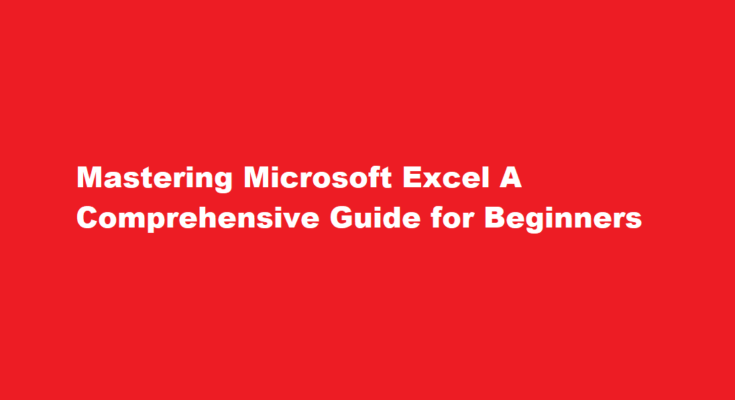Introduction
Microsoft Excel is a powerful spreadsheet software that has become an indispensable tool for businesses, students, and individuals across the globe. Whether you are managing finances, analyzing data, or creating charts and graphs, Excel simplifies complex tasks and enhances productivity. In this article, we will provide a step-by-step guide for beginners to effectively use Microsoft Excel. From basic functions to advanced features, this comprehensive tutorial aims to equip you with the knowledge and skills needed to navigate Excel confidently and efficiently.
Understanding the Excel Interface
Upon launching Excel, you’ll be greeted by a blank workbook containing a grid of cells. Familiarize yourself with the Ribbon, where all the commands are organized into tabs, and the Formula Bar, where you can input and edit cell contents. Get comfortable with navigating the worksheet by scrolling, zooming in and out, and moving between sheets. Knowing how to manipulate the worksheet layout is crucial to making the most of Excel’s capabilities.
Entering Data
Begin by typing data into cells. Excel supports various data types, including numbers, text, dates, and formulas. Use basic keyboard shortcuts to speed up data entry, such as “Enter” to move to the next cell and “Tab” to move horizontally. Employ autofill to quickly replicate data patterns and formulas across a range of cells. Remember to format cells appropriately to ensure data consistency and visual appeal.
Basic Formulas and Functions
Excel’s true power lies in its ability to perform calculations effortlessly. Learn the basics of creating formulas to add, subtract, multiply, and divide numbers. Explore built-in functions, such as SUM, AVERAGE, COUNT, and MAX/MIN, to analyze data effectively. Utilize logical functions (IF, AND, OR) to perform conditional calculations. Mastering these fundamental features will streamline your data processing tasks and save time.
Data Visualization with Charts
Excel offers a wide range of chart types to present your data visually. Create impressive bar charts, line graphs, pie charts, and more to gain insights and communicate information effectively. Customize your charts by adding titles, labels, and changing colors and styles. Excel’s charting tools enable you to present data in a compelling and easily digestible manner.
Sorting and Filtering Data
Dealing with large datasets can be overwhelming. Excel’s sorting and filtering capabilities make it easy to organize and extract specific information. Sort data alphabetically or numerically and apply multiple-level sorting for complex datasets. Filtering enables you to display only relevant data based on specific criteria, enhancing data analysis and decision-making.
Conditional Formatting
Highlighting important data using conditional formatting can significantly enhance the readability and understanding of your spreadsheets. Apply colors, icons, and data bars based on specific conditions or rules, drawing attention to significant trends, outliers, or values that meet certain criteria.
Data Analysis with PivotTables
PivotTables are Excel’s powerhouse for data analysis. They allow you to summarize and analyze large datasets quickly and efficiently. Learn how to create PivotTables, rearrange fields, and apply filters to gain valuable insights. Excel’s PivotCharts complement PivotTables, providing dynamic visualization options for your data.
FREQUENTLY ASKED QUESTIONS
Can we learn Excel in 2 days?
Although it’s possible to gain a basic understanding of Excel’s interface and core functions in just a few hours, it can require additional time and study to master its more complex capabilities. It takes most Excel users approximately 18-20 hours to fully learn this spreadsheet application.
What is a formula in Excel?
In Microsoft Excel, a formula is an expression that operates on values in a range of cells. These formulas return a result, even when it is an error. Excel formulas enable you to perform calculations such as addition, subtraction, multiplication, and division.
Conclusion
Mastering Microsoft Excel is a valuable skill that empowers users to organize, analyze, and visualize data seamlessly. From basic data entry and formula creation to advanced features like PivotTables, this comprehensive guide equips beginners with the necessary tools to excel in Excel and maximize productivity in various personal and professional endeavors.
Read Also : The Perfect Omelette A Simple Guide to Mastering the Art of Omelette Making



